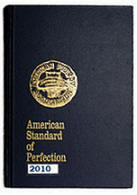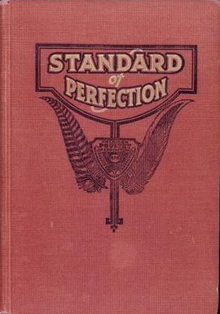| Silver Laced Wyandotte Cockeral |
Sure one trio or a foursome is a good start, but to make progress faster, set up 3 breeding pens (in this article a breeding pen is a trio or a foursome). Pick out the best birds that you can and look them over carefully referring to the Standard of Perfection (SOP). They do not need to be perfect (but as close as possible). Eliminate obvious defects, such as wry tails, deformed toes or beaks, wrong type of comb, poor coloring, poor type, poor size or weight, slipped wings the list goes on. The trios should be all from the same line. Keep track of everyone with bands and write down all your info into a journal. Differentiate between the trios with letters, numbers or colors. Always cull down to the best out of each hatch.
• Pen number 1(A) or line 1 is banded with a 1 or (A)
• Pen number 2(B) or line 2 is banded with a 2 or (B)
• Pen number 3(C) or line 3 is banded with a 3 or (C)
• If you don't have bands use plastic ties that are colored, but keep each trio with its own
unique identifying marker. Their children need to be marked accordingly. From birth. You
can use a toe punch to mark the offspring. Also make a family tree for your trios. If a parent is unknown write unknown. If a bird looks good and its lineage is unknown that's O.K. What matters is that the bird looks good. Make sure to mark your eggs according to the parents and keep them separated in the hatching tray. They should be toe punched asap (see chart below). Once all breeding pens are set up and the birds are marked follow the instructions below.
For Season 1, mate all males to females of their own line.
| Silver Laced Wyandottes |
From your first hatch the best Daughters of Season 1 are added as breeders to the line that produced them (they stay with their mothers.) This is why you toe punch the young so that you will know which daughters came from which mothers. (Sons are compared to their fathers for quality and only the best are kept in a bachelor pen until needed). A bachelor pen is a separate pen for all your roosters that are not being used.
In Season 2, mate the 3 or C line male to the 2 or B line females, mate the 2 or B line male to
the 1 or A line females, mate the 1 or A line male to the 3 or C line females - rotating them.
Females from Season 2 are added to the line that produced them alongside
their mothers. The best son of the 3 or C line male mated to the 2 or B line females is
kept and mated to the 2 or B line females; same for other matings, old cocks are
retired.
Once everything is going well males are used twice, then retired and replaced by a son. Males rotate one line over every other year. This gives you a year of out cross and a year of line breeding.
You will need
- • at least 3 different pens
- 3 different trios of birds of the same variety
- • Leg or wing bands
- • toe punch
- a detailed journal book
Toe Punching
A toe punch is a small tool used to make a tiny hole in the web of a chicken or other fowl's foot. There are two webs on each foot and two feet on each bird for a total of 16 possible combinations for each variety. See chart below for the different combinations.











